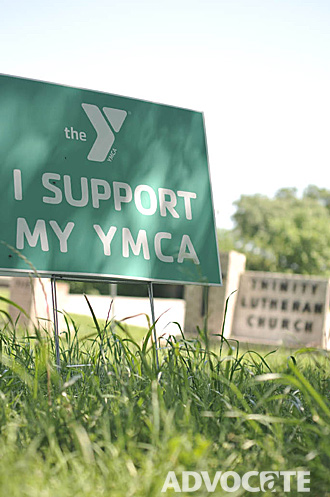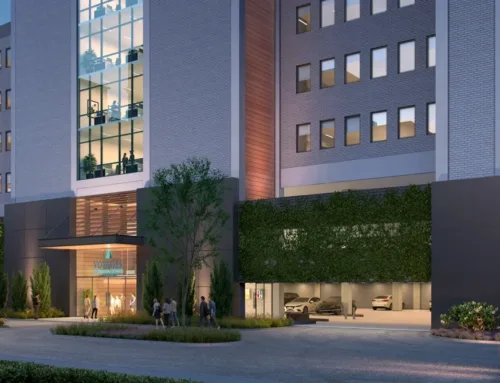One man stands alone in opposing a new home for the YMCA

Signs like this one are in front yards all around the former Trinity Lutheran Church property on Gaston. The White Rock YMCA hopes to receive the city’s approval for its zoning request this month. Photo by Can Türkyilmaz
Joe Kast stands in his front yard and looks directly across the street at the former Trinity Lutheran Church building on Gaston at Loving.
The White Rock YMCA plans to build a new center on the site, and Kast’s neighborhood has all-but rolled out the red carpet, endorsing the required zoning change and shrugging off the increased traffic and activity a new facility will inevitably create.
Kast stands alone, straddling the line of supporting the Y’s mission but believing the new facility will lower his home value. After all, he says, the Y’s driveway will point straight at his house, negatively impacting his home value, even as neighbors believe the project will increase the value of their homes by making permanent the green space near Gaston and offering a neighboring fitness facility across the street.
“For a period of years, we’ve kind of all been together on, is this going to be good for the neighborhood or is it not?” Kast says.
Now, however, he finds himself isolated, worried about how something most everyone else believes will be good for the community will be bad for him.
“I don’t know what to do,” says Kast, who, after three decades of living in the same house, is talking about turning it into a rental property.
“Why stay?” he asks.
A brief history lesson
After Kast moved into his Tudor-style home on the corner of Loving and Clayton, the church property wasn’t a bother. He doesn’t remember more than 30 cars in its parking lot at a time.
But several years ago, the church closed, and every potential neighbor since then has raised his blood pressure.
First was a skilled nursing home, with its promise of ambulance sirens and delivery trucks. Other proposals were for condos and townhomes that would guarantee more people, cars and noise.
Each prospective new use required city approval of the requested rezoning (the property is zoned single-family now), and that’s not what Kast and his neighbors signed up for when they bought their houses. So one by one, they successfully fended off every proposed project.
And, in fact, the neighbors don’t have to support a change in zoning of any sort. Typically churches are allowed to build in single-family neighborhoods with a zoning use that reverts to single-family if and when the church leaves the property. The automatic zoning reversion protects property owners who buy homes next to the church, since they know the underlying zoning prevents a shopping center or liquor store or restaurant from popping up outside their window without city approval.
A few months ago, however, the White Rock YMCA announced plans to buy the vacant church property subject to obtaining a required zoning change from the city. It turns out the Y’s existing property a few blocks east on Gaston is under contract to Lincoln Property Co. Lincoln also is negotiating to purchase the Far West nightclub property, which has been a perennial pain to neighbors tired of the club’s traffic and disruptive patrons spilling onto their streets.
The announcement that the Y wanted to move to the church property, coupled with the linked elimination of the nightclub, generated big smiles from neighbors in Lakewood Hills (its name recently changed from Gastonwood/Coronado Hills). A good chunk of them are Y members and are eager to walk or ride their bicycles to the Y.
Everyone seems thrilled. Everyone, that is, except Kast.
“The only home in the entire neighborhood that has an entrance pointed at it is my home,” he says, referring to the Y’s site plan that would route cars in and out right beside his driveway. The only other entrance would be on Gaston.
Kast says he can’t muster excitement about the prospect of hundreds more cars driving past his home every day or dealing with headlights glaring into his windows.
Whose property rights are supreme?
Kast finds himself at the center of a utilitarian problem that often confronts neighborhoods when the possibility of change is coming: What happens when something that may be good for the whole hurts a few neighbors — or, in this case, perhaps just one?
Though Kast says he’s dejected by the lack of neighborhood support for his position, he empathizes with his neighbors. They’re tired of fighting developers. An abandoned church building doesn’t bode well for property values. Even though the land is zoned for single-family homes, he knows the property’s price tag, $2.1 million, wouldn’t make for a very profitable single-family development.
One difference between the White Rock Y and other developers who tried and failed is that the Y did its homework. Santos Martinez, a senior consultant for Masterplan who is representing the Y, says they scoured the backlog of concerned emails and letters the city received about prior rezoning requests.
“Saving the trees was paramount in all of those discussions,” Martinez says, as was retaining green space and diverting parking away from Loving. The Y incorporated these requests into its site plan with ample green space fronting the streets lined with homes.
By the time plans were presented to neighbors at Lakewood Hills’ quarterly meeting in March, one of the more popular questions was, “How can we make this happen?”
“The Y seems to be a match made in heaven,” says Stewart Cockrell, president of the Lakewood Hills Neighborhood Association. Cockrell says the association surveyed neighbors and discovered they “overwhelmingly” support the Y’s move, and some living near the property even responded, “Oh thank god. We’ve waited for something like this.”
At the meeting, Kast stood up and gave a last ditch argument for another entrance that would divert traffic away from his house. A couple of neighbors spoke on his behalf, requesting that the Y do whatever it could for Kast since he has been a good neighbor. Others, however, seemed frustrated at Kast’s opposition to the Y.
After that, Kast says, “I threw up my hands.”
Martinez and others from Masterplan and the Y have spent time with Kast trying to devise solutions to the impact on his property; Cockrell estimates they have devoted roughly 10 hours to working with Kast.
“The Y has really done all they can do, short of not building there, to appease Joe and to make him happy,” Cockrell says.
The Y’s requested zoning change is slated for the Dallas Plan Commission’s May 3 agenda. Gloria Tarpley is the city plan commissioner following the zoning case, and Tarpley says her primary focus is always to “look very carefully to what you’re doing to piece of property and make sure it fits in its context and in its setting.”
In the case of the Y, she says it’s “a particularly good use for that piece sandwiched between the apartments and the houses.”
She says she’s also hearing overwhelming support of the project, except for the feedback from Kast.
“What I try to do is to be very sensitive to all of the neighbors and see if we have an applicant that is willing to go to great lengths to meet and accommodate some of the concerns of the neighbors,” she says.
The Y has done just that, she says.
“In a perfect world, you would have everybody happy,” Tarpley says. “In a less than perfect world, you can try to lessen the impact as much as possible.”
The end of the line
Kast has resigned himself to living in a less-than-perfect world. The writing on the wall is clear, and not just metaphorically. Green signs proclaiming “I support my YMCA” sprout from yards all around him.
Even his wife, Donella, wants to put one in their yard, Kast says.
“I can’t quite bring myself to do it, but Donella will probably end up winning out,” he says.
He believes the Y is the most neighborhood-friendly development that has come along since the church closed. He also knows its relocation, along with the closing of Far West and Lincoln Property Co.’s resulting redevelopment of the entire corner of Gaston and Garland/East Grand, could have an huge, positive impact on the neighborhood.
“You look at the benefit to everybody. It just wouldn’t take much of a developer to turn that all around,” Kast says.
Still, he maintains, “it’s going to be hard for somebody to live in this home.”
Martinez is not only representing the Y on the zoning case but also a Hollywood Heights resident and former White Rock Y chairman. He emphasizes that the Y “wants to be good neighbor.” He has repeated this phrase many times, both at the Lakewood Hills meeting and in interviews.
Kast wants to believe the assurances, but the possibility of spiking noise and traffic and plummeting property value nags at him.
If the “I support my YMCA” sign does wind up in his front yard, he says that another sign will likely accompany it:
“For lease.”
Read about Lincoln Property Co.’s potential purchase of the Y/Far West site





